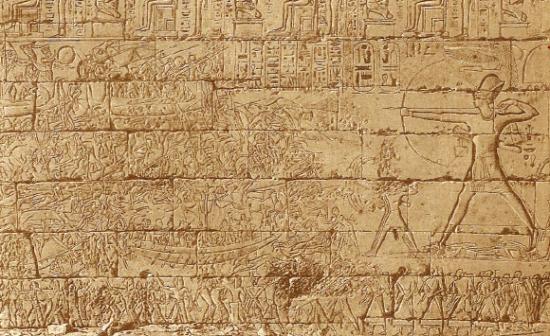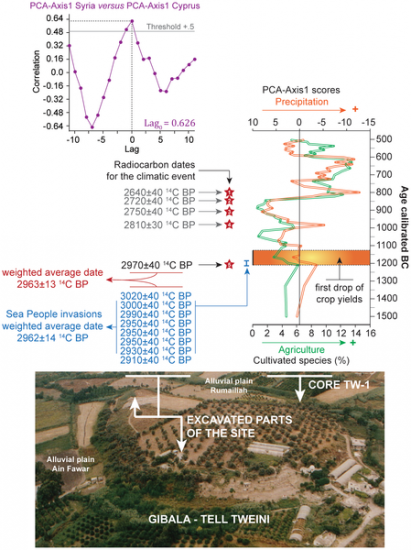Enrico de Lazaro
Source - http://www.sci-news.com/archaeology/science-collapse-late-bronze-age-civilizations-climate-change-01316.html
According to a new study reported in the open-access journal PLoS ONE, climate change may have driven the collapse of Eastern Mediterranean civilizations around 1300 – 1200 BC.

Hieroglyphic and cuneiform texts portray the proximate cause of the collapse of the late Bronze Age civilizations as the invasions of the Sea Peoples. But the new study says the Eastern Mediterranean cultures suffered wars, famine fuelled by climate change. The picture shows Sea Peoples in their ships during the battle with the Egyptians (Drawn by Boudier from a photograph by Beato).
Ancient civilizations flourished in regions of the Eastern Mediterranean such as Greece, Syria and neighboring areas, but suffered severe crises that led to their collapse during the late Bronze Age (LBA).
In the study, lead author Dr David Kaniewski from the Université Paul Sabatier-Toulouse and his colleagues from Belgium and France studied pollen grains derived from sediments of an ancient lake in the region to uncover a history of environmental changes that likely drove this crisis.
Shifts in carbon isotopes in the Eastern Mediterranean and in local plant species suggest that this lake was once a flourishing harbor that gradually dried into a land-locked salt lake.

Map of Cyprus with an overview of the Larnaca Salt Lake (Hala Sultan Tekke) in the Larnaca Bay. Core B22 is indicated by a red star in the modern salty area. High concentrations of Posidonia oceanica fibers are highlighted in the corer, and in lower samples. doi:10.1371/journal.pone.0071004.g001
As a result, crop failures led to famines, repeated invasions by migrants from neighboring regions and eventually, the political and economic collapse of the Eastern Mediterranean civilizations.
Combining new data with archeological evidence from cuneiform tablets and correspondence between kings, the team suggests that the late Bronze Age crisis was a complex, single event comprised of climate change-induced drought, famines, the Sea People invasions and political struggles, rather than a series of unrelated events.
“By combining data from coastal Cyprus and coastal Syria, this study shows that the LBA crisis coincided with the onset of a 300-year drought event 3200 years ago. This climate shift caused crop failures, dearth and famine, which precipitated or hastened socio-economic crises and forced regional human migrations at the end of the LBA in the Eastern Mediterranean and southwest Asia,” the scientists explained in the paper.
They conclude that this event underlines the sensitivity of these agriculture-based societies to climate, and demystifies the crisis that led to their end.
Bibliographic information: Kaniewski D et al. 2013. Environmental Roots of the Late Bronze Age Crisis. PLoS ONE 8 (8): e71004; doi: 10.1371/journal.pone.0071004
Abstract
The Late Bronze Age world of the Eastern Mediterranean, a rich linkage of Aegean, Egyptian, Syro-Palestinian, and Hittite civilizations, collapsed famously 3200 years ago and has remained one of the mysteries of the ancient world since the event’s retrieval began in the late 19th century AD/CE. Iconic Egyptian bas-reliefs and graphic hieroglyphic and cuneiform texts portray the proximate cause of the collapse as the invasions of the “Peoples-of-the-Sea” at the Nile Delta, the Turkish coast, and down into the heartlands of Syria and Palestine where armies clashed, famine-ravaged cities abandoned, and countrysides depopulated. Here we report palaeoclimate data from Cyprus for the Late Bronze Age crisis, alongside a radiocarbon-based chronology integrating both archaeological and palaeoclimate proxies, which reveal the effects of abrupt climate change-driven famine and causal linkage with the Sea People invasions in Cyprus and Syria. The statistical analysis of proximate and ultimate features of the sequential collapse reveals the relationships of climate-driven famine, sea-borne-invasion, region-wide warfare, and politico-economic collapse, in whose wake new societies and new ideologies were created.

Figure 6. Radiocarbon-based archaeology, climate and agricultural productivity from Gibala-Tell Tweini, Northwest Syria.
The pollen-derived climatic and agricultural proxies are plotted against time (1500–500 cal. BC). Radiocarbon dates for the ca. 300 year dry event are indicated with red stars. The time-window of the invasions at the Bronze-Iron Age boundary is framed by radiocarbon dates from the destruction layer (blue). At the top, the cross-correlogram shows the correlation between the pollen-derived proxy of moisture availability from Hala Sultan Tekke and that from Gibala-Tell Tweini. Vertical axes show correlation coefficients while horizontal axes show the lag (1 unit = 1 sample). Significance level P = 0.05. doi:10.1371/journal.pone.0071004.g006